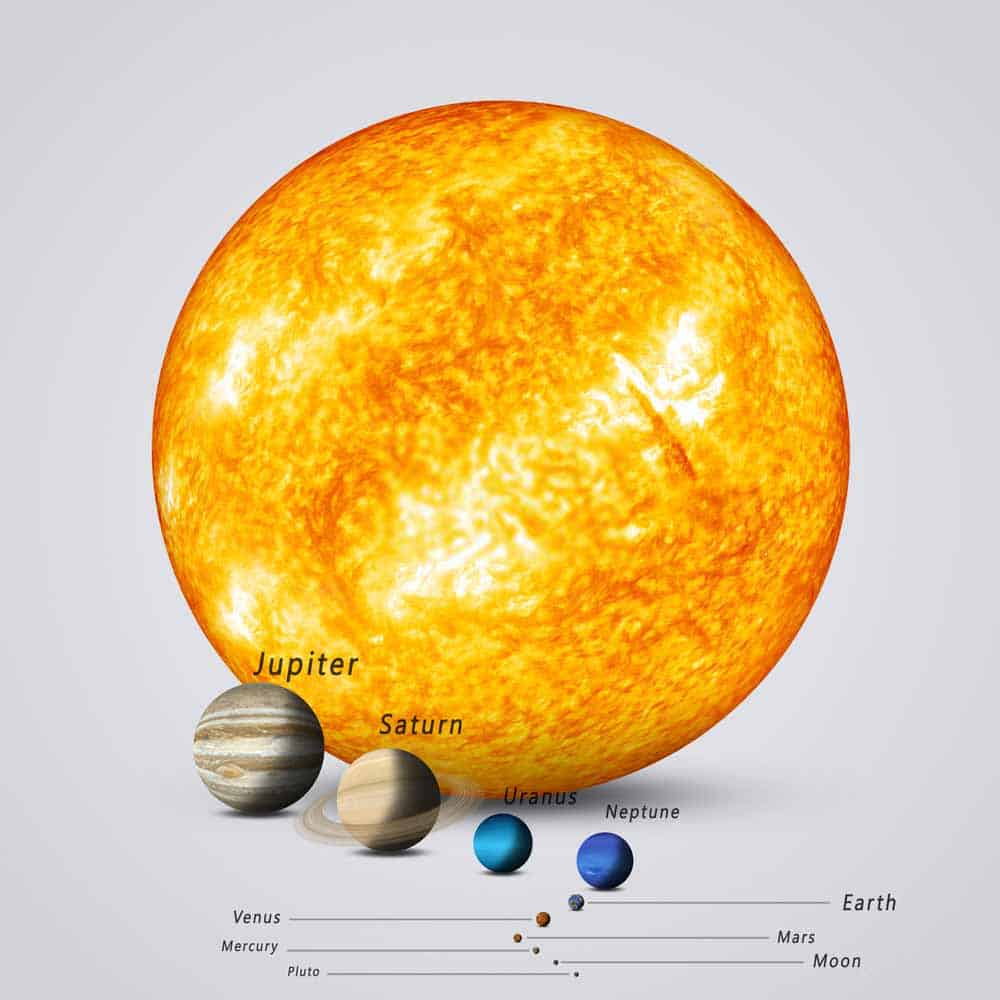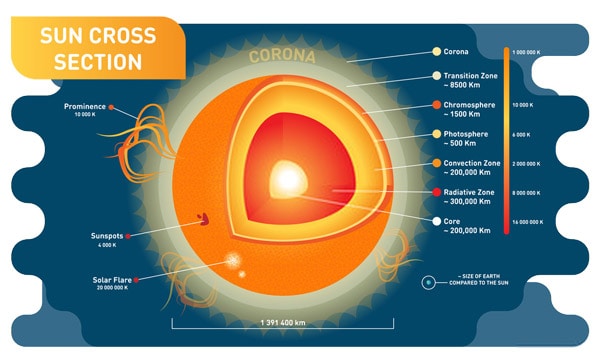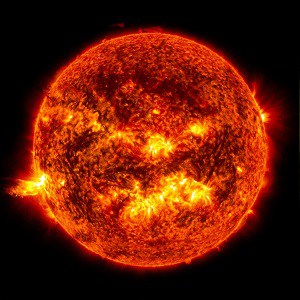
- Age: 4.6 Billion years
- Type: Yellow Dwarf
- Diameter: 856,373 miles (1.4 million km)
- Circumference at Equator: 2.7 million miles (4.4 million km)
- Mass: 333,000 times the mass of Earth (1.989E30 kg)
- Speed: 136 miles (220 km) per second
- Core Temperature: 27 million °F (15 million °C)
- Distance: 91 to 60,894 million miles from Earth (147 to 152 million km)
- Surface Area: 2,350,512,334,977 square miles (6,087,799,000,000 square kilometers)
- Layers: 6
- Size: The Sun Is Huge
- Location: The Sun Is the Closest Star to Earth
- History: There Is No Discovery Date for the Sun
- Longevity: The Sun Will Run Out of Energy
- Mass: There Is Nothing Solid on the Sun
- Distance: Light Takes 8 Minutes to Reach Earth from the Sun
- Makeup: The Sun Has 6 Layers
- Produces: The Sun Produces Solar Wind
- Temperatures: Temperatures Change Throughout the Sun
- Gravity: Planets and Smaller Objects Orbit the Sun
- The Sun Has Been Worshiped
- Ancient Mummies Have Been Found With Tattoos of the Sun
- The Sun’s Power Cannot Be Duplicated
- Different Parts of the Sun Rotate at Different Speeds
- One Million Earths Could Fit Inside the Sun
The Sun Is Huge

According to basic Sun facts, the Sun is 109 times the size of the Earth. When compared to all the other mass in our solar system, the sun makes up 99.86%. Everything in the solar system is affected by the Sun’s gravitational pull. If you were able to stand on the Sun, your weight would be 28 times higher than it is on Earth because of the much stronger gravitational pull. The Sun’s surface area is nearly 12,000 times the size of Earth.
The Sun Is the Closest Star to Earth
The Sun is a star that is the closest in relationship to Earth, and is the center of our universe. It is of average size when compared to other stars. It is considered to be a young star, and is dated at 4.6 billion years old, compared to other stars that are 15 billion years old.
There Is No Discovery Date for the Sun
The Sun is unique in that there is no date for its discovery. Almost all planets, stars and other parts of the solar system have a specific date on which they were discovered. Because the Sun has been known by mankind since the beginning of time, there is no discovery date.
The Sun Will Run Out of Energy
To date, the Sun has used up half of the hydrogen in its core. It burns four million tons of hydrogen per second. As it loses more hydrogen, the Sun’s core will have to find ways to keep producing enough pressure or it will collapse in on itself. The only way to do this is to increase its temperature. In about 5 billion years it will run out of hydrogen fuel and will be forced to radically change. This will most likely result in the end of Earth as we know it. It is believed that as the sun heats up, human life will not be able to withstand the temperatures within the next billion years.
There Is Nothing Solid on the Sun
While many planets are made up of solid materials, sun facts reveal that the sun is only compromised of gas. It is made up of 73.46% hydrogen and 24.85% helium. The last 1.69% is a mixture of neon, carbon, iron, nitrogen and silicon.
Light Takes 8 Minutes to Reach Earth from the Sun
The average distance of the Sun from Earth is 93 million miles (150 million km). The light from the sun travels at 186,411 miles (300,000 km) per second. It can be calculated to show that it takes light about 8 minutes and 20 seconds to reach Earth. While this is only a few minutes, the true calculations are a little more in depth. Light goes through a much longer journey within the Sun and therefore the light that took 8 minutes to reach you was actually in the Sun for tens of thousands of years. Looking at the Sun is actually like looking into the past.
The Sun Has 6 Layers

The Sun can be divided into six layers, according to sun facts. They go in order as follows, starting in the middle of the sphere: the core, the radiative zone, the connective zone, photosphere, chromosphere and finally the corona. The core produces the Sun’s energy while the radiative zone carries out the energy. The energy moves into the connective zone and up onto the Sun’s surface, known as the photosphere. The outside of the surface is made up of the chromosphere and the corona. They are very faint, but can be seen on an overcast day.
The Sun Produces Solar Wind
The solar wind produced by the Sun contains charged particles, such as electrons and protons. They propel from the Sun and are only able to escape its gravitational force with their high kinetic energy. The Earth is able to deflect these charged particles thanks to its strong magnetic fields.
Temperatures Change Throughout the Sun
Temperatures vary throughout the Sun’s layers. The core reaches temperatures higher than 27 million degrees Fahrenheit. While this heat and energy travels throughout the next few layers, the temperature drops to 3.5 million degrees Fahrenheit. As heat continues to the chromosphere, it cools to 7,800 degrees Fahrenheit. When it hits the outer corona layer it warms up again to 3.5 million degrees Fahrenheit.
Planets and Smaller Objects Orbit the Sun
Mercury, Venus, Earth, Mars, Jupiter, Saturn, Uranus, Neptune and Pluto all orbit the sun. Asteroids, meteors, satellites and comets can all also be captured in the Sun’s orbit. All of these items orbit in the same direction, and on roughly the same plane.
The Sun Has Been Worshiped
Sun facts reveal that the Aztec civilization was known to worship the Sun as a God. The mysterious stone circles known as Stonehenge in the UK are believed to be part of a religious worship that involved the Sun. Ancient Egyptians had a sun god called Ra.
Ancient Mummies Have Been Found With Tattoos of the Sun
In Libya, both male and female mummies have been discovered with tattoos of the Sun on their bodies. This lends more support to the belief that the Sun was extremely important to various ancient cultures and religions.
The Sun’s Power Cannot Be Duplicated
If one were to try to imitate and match the amount of power contained within the Sun, 100,000,000,000 tons of dynamite would have to be detonated every single second of every minute of every day.
Different Parts of the Sun Rotate at Different Speeds
Because the Sun is made up of gas and not solid matter, different parts rotate at different speeds. Sections at the equator can take 25 days to complete a full rotation, but the sections near the poles of the Sun can take up to 36 days. The core of the Sun takes about 27 days.
One Million Earths Could Fit Inside the Sun
If the Sun were hollow, almost one million Earths would fit inside. If you were able to cut apart the Earth in order to fill every bit of empty space, then 1,300,000 Earths would fit inside the Sun.
Sun Facts – Facts about the Sun Summary
 Sun facts show just how large the star is, and describe the different layers that make up the Sun. They also go into the details of the different temperatures found throughout the Sun, what orbits the Sun, and the Sun’s significance to cultures and religions throughout history.
Sun facts show just how large the star is, and describe the different layers that make up the Sun. They also go into the details of the different temperatures found throughout the Sun, what orbits the Sun, and the Sun’s significance to cultures and religions throughout history.
Was this page helpful?
Our commitment to delivering trustworthy and engaging content is at the heart of what we do. Each fact on our site is contributed by real users like you, bringing a wealth of diverse insights and information. To ensure the highest standards of accuracy and reliability, our dedicated editors meticulously review each submission. This process guarantees that the facts we share are not only fascinating but also credible. Trust in our commitment to quality and authenticity as you explore and learn with us.
